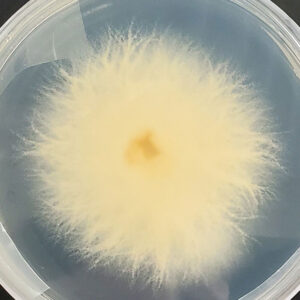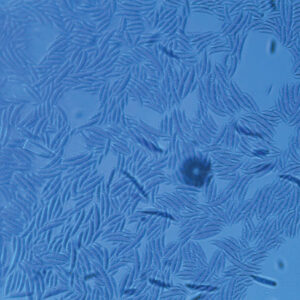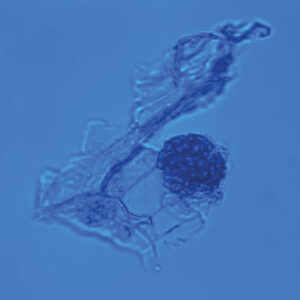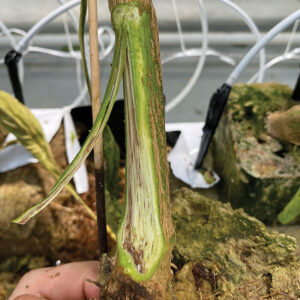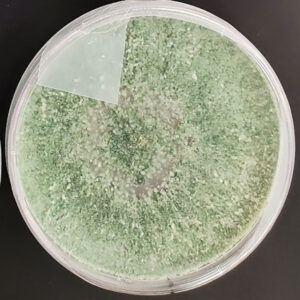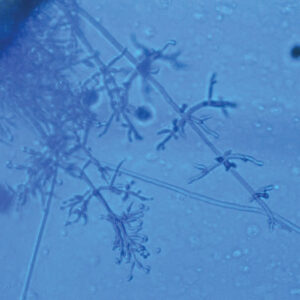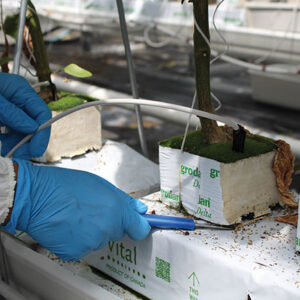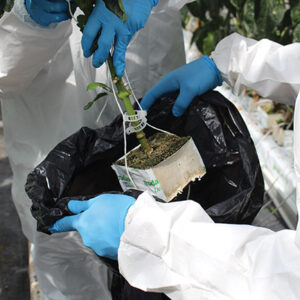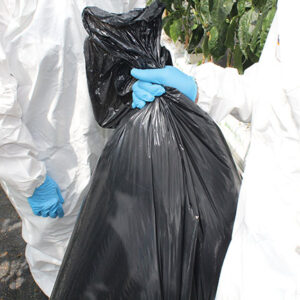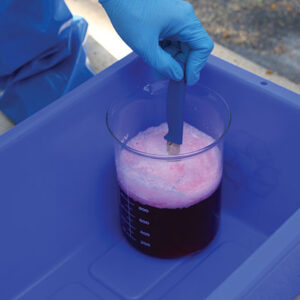
Features
Mission possible: Investigating root rot
Proper pathogen identification is a crucial first step in deciding how to address root rot and other plant disease and requires a little detective work in order to be accurate.
September 1, 2023 By Cara McCreary, Katie Goldenhar, and DR. Geneviève Marchand
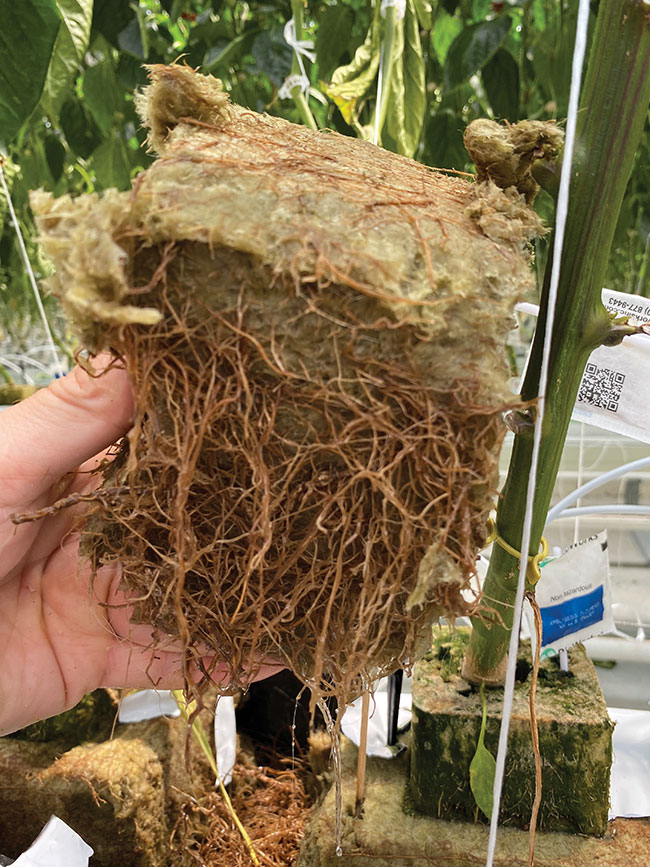 Figure 1. Brown, discoloured roots is a symptom of root rot in greenhouse peppers.
Photo credit: © King’s Printer for Ontario, 2022.
Figure 1. Brown, discoloured roots is a symptom of root rot in greenhouse peppers.
Photo credit: © King’s Printer for Ontario, 2022. Root rot is a bit of a catch-all term for a plant disease that has “roots” that are “rotting”. Sometimes rot root is accompanied by other symptoms in the crown, stem, or vascular system. Other terms used for these types of diseases include crown and root rot, stem and root rot, wilt and root rot, pre-emergence damping off, or post-emergence damping off. No matter what the disease is called, the most important thing to remember is that there is a disease-causing agent involved (a.k.a. “the Offender”). In other words, a plant pathogen, which under the right environmental conditions, can infect a susceptible plant host.
Root rot is not new in greenhouse production; however, the extent of disease can vary from year to year. The tricky part is figuring out what the disease-causing organism is (the plant pathogen). Unlike more conspicuous diseases like Botrytis grey mould or powdery mildew, determining which pathogen has infected plant roots just by looking at them is not possible (Fig. 1). It is also possible, or even likely, that the roots are infected with more than one pathogen. Proper pathogen identification greatly matters for decision making so put on your Sherlock hat, get out your spy glass, and investigate!
Why the detective work?
There are several reasons why it is important to investigate the causal agent. They may have different:
- routes of introduction
- optimum environmental conditions
- host ranges
- management options
The culprits
In greenhouse vegetable and soft fruit crops, there are common pathogens frequently associated with root rot. Many are ubiquitous and vary in response to treatment, aggressiveness, preferred environmental conditions, and host preferences. We can broadly group them into two distinct groups: fungi and oomycetes (water moulds).
Fusarium species
Fusarium species are true fungi. The genus Fusarium contains several species that are economically important fungal plant pathogens worldwide. Although several species of Fusarium cause disease in greenhouse crops, the species implicated in root rot, crown rot, and wilt is most often Fusarium oxysporum (Fig. 2). This pathogen has a wide host range, including more than 600 known plant species. Some strains of F. oxysporum are endophytic: colonize the vascular system of plants without harming them and can even offer some benefits to their hosts. Disease causing strains of F. oxysporum that are better adapted to infect a specific host crop, or part of the host (for example, roots), are usually functionally classified as a special form (forma specialis or f. sp.). However, genetically speaking, isolates within the same special form may not be all that closely related, which complicates diagnosis.
Pythium species
Pythium species are another common group of plant pathogens that can cause root rot (Fig. 3). They are oomycetes, a group that may look like true fungi but are genetically more distant. Their biology and biochemistry differ from true fungi in many aspects which has important implications for management. Root rot initiation by Pythium species often takes place in wet conditions like contaminated hydroponic nutrient solution.
Phytophthora species
Phytophthora species are also oomycetes though seem to be less commonly associated with root rot in greenhouse production. Phytophthora capsici and P. cactorum are soil or seed borne pathogens causing root and crown rot in various crop species and are not typically airborne. Phytophthora infestans is the causal agent of tomato late blight, which can also be soil or seed borne, but in hydroponic systems, it is typically airborne sporangia infecting aerial plant parts.
Identifying the offender(s)
There are a few things worth noting, when investigating the causal organism of root rot and exploring solutions.
- Symptoms (root discolouration, crown rot, stem rot, wilt, vascular symptoms (Fig. 4)
- Disease incidence (percentage of plants/houses/acres infected) and severity (percentage of roots rotted)
- Rate of spread (days, weeks, months)
- Treatment applications (preventative biopesticides, conventional pesticides)
- Genetic tolerance of cultivars
Management decisions begin with identification of the pathogen. This is often best left to a diagnostic laboratory that is equipped to distinguish between many different species, and possibly special forms and races. However, sometimes we encounter a new pathogen or one that has evolved to become more virulent or has expanded its host range. When sampling for diagnostic purposes, keep in mind that the accuracy of the results relies on the quality of the sampling.
The penalty (Management options)
Since most of the culprits are ubiquitous, eradication may not be a realistic goal. Instead, the focus should be on optimizing plant health and minimizing plant stress. This can be done with various techniques aimed at reducing pathogen exposure and plant health promotion. Up the barricades and arm the plants with self-defence tactics!
Sanitation. Practicing good employee hygiene, keeping the production space clean and conducting a thorough clean out between crops is essential to reduce pathogen load (the amount of pathogen present).
Host resistance. When possible, using cultivars or root stocks with pathogen resistance can provide significant protection. Unfortunately, such resistance is not always an option.
Disease-free seed/seedlings. Like producers, seed raisers and propagators use similar crop protection tactics to supply “clean” seed and “healthy” seedlings. Producers should monitor seedlings for signs of root rot and promptly remove suspicious plants.
Disinfecting recirculated nutrient solution. Clean source water mitigates the risk of introduction into the greenhouse through irrigation channels. Disinfecting recirculated nutrient solutions prevents pathogen levels from building over time. There are many types of disinfection systems that can suit a range of situations.
Commonly used systems include:
- Physical filtration
- Biofiltration (slow sand filters)
- Ultraviolet (UV) light
- Ozone
- Pasteurization
Newer systems include:
- ECA (Electro Chemical Activated)
- Ultrasonic transmitters
All systems should include some form of filtration to eliminate constituents that will negatively impact the success of the primary system. In many cases, multiple disinfection systems are used to increase the likelihood of success.
Environmental manipulation. Once the causal agent has been determined, consider disrupting the optimal conditions for the pathogen without compromising crop production. Temperature, moisture, pH, EC, and nutrients (specifically nitrogen levels and source) are important variables to consider. For example, maintaining the nutrient solution and root zone temperatures at or below 20 degrees celcius, can reduce the incidence and severity of root rot. Overwatering or underwatering, overfertilization or underfertilization, can all add to plant stress and increase the chance of disease development.
Proactive use of beneficial microbes. Many microbial crop protection products (biopesticides) are registered for use in greenhouse production for protection in the root zone including Bacillus, Streptomyces, and Trichoderma species (Fig. 5) and/or their metabolites. Each beneficial microbe species or strain may have different efficacy levels for different pathogens.
In general, these microbes offer the plant protection through:
- Competition – colonize the roots and compete with the pathogen for nutrients and space.
- Parasitism – come in physical contact with and directly attack the pathogen.
- Antibiosis – produce molecules that are toxic to pathogens or inhibit their growth.
- Inducing metabolic changes in the crop plant – encourage the plant to release defense compounds and mobilize other resistance mechanisms.
- Plant growth promotion – promote growth of plant roots and shoots, increase productivity, and improve nutrient uptake.
As these are living organisms or their byproducts, storage, shelf-life, and handling is important for their success. Generally, efficacy is greatest when they are used preventatively and reapplied according to label recommendations.
Roguing. Through diligent monitoring, removing infected plants and sometimes growing media early in production can reduce the spread of disease. Infected plants should be disposed of appropriately to minimize the risk of recontamination.
Use of conventional fungicides. When necessary and combined with other tactics, fungicides can help further suppress the pathogen.
Rotation. Switching to a non-host crop is not always simple but can help reduce the incidence of disease in some cases.
There is much to learn about plant pathogens and specifically those causing root rot. A team of investigators (research scientists, diagnosticians, specialists, industry, etc.) continues to work together to learn more about these tiny organisms that throw curve balls at growers year after year. You know the old saying: knowledge is power? The more we learn, the better equipped we are to “arrest” the plant pathogens once and for all.
Cara McCreary, Greenhouse Vegetable IPM Specialist, Ontario Ministry of Agriculture, Food and Rural Affairs
Katie Goldenhar, Pathologist – Horticulture, Ontario Ministry of Agriculture, Food and Rural Affairs
Dr. Geneviève Marchand, Research Scientist – Plant Pathology, Agriculture and Agri-Food Canada
Print this page
